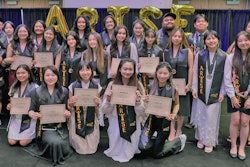It May Be Tough, but A Multiracial Identity Is Not a Crisis
By Terrence J. Lee-St.John
Terms like “Black issues” used to make me feel uncomfortable. I am of racially mixed parentage and have never really felt like I belonged to a particular community — African American nor Asian American nor Native American.
The first time I was made aware of my ethnic background was in elementary school in Washington, D.C. I had previously been enrolled in a Montessori program at another D.C. public school and was shocked by the way my classmates treated me at my new school.
Like my old school, the new school was predominately Black. Having a Chinese American mother and an African American father, I stood out in the crowd. I was something different. I was not defined by my personality. And, I was not considered Black — or even partially Black. I was only Chinese. Being in the school’s academically gifted program also set me apart and fed stereotypes about me being a “smart Chinese.” From first through third grade, I was taunted, harassed, and sometimes even physically abused for being “different.”
This three-year experience negatively affected my self-definition. It left me confused and bitter. The intense animosity I experienced unfortunately became imprinted in my memory and is now the strongest recollection I have from my years at that school. By the time I completed third grade, though I knew I was of Black ancestry, I no longer considered myself a part of the Black community.
After a third-grade bathroom confrontation with a boy who taunted me with martial arts kicks and chops, my parents decided that I should move to a different learning environment and enrolled me in a private school. However, this change did not completely free me from the label I was trying to shed.
Capitol Hill Day School was a completely different setting. My classmates were now predominately White, and mostly came from upper-middle-class families. But again, I stood out in the crowd. But this time, I was not seen as Chinese; I was considered Black. However, my racial background did not bring taunts from my classmates. But my new “identity” confused me at that time because my previous experience had estranged me from the Black community.
By seventh grade, I had come to realize that I no longer cared about belonging to any particular racial community. As I matured, I began to define myself as what I truly am — a rarely encountered mix of Chinese, Black and Native American. This is also the time when my parents decided that I should be more challenged in my education and enrolled me in The Sidwell Friends School, another well-respected private school in the nation’s capital.
The major change that came with my new school — besides a more rigorous academic workload — was a strong focus on current events. My classmates all seemed to be informed on politics and other aspects of the news. I started noticing racially based news stories. Rodney King, Native American casino issues, Black church burnings and other such stories all had an affect on the way I saw the world. I could not understand why there were so many conflicts based solely on race. Living in Washington, D.C., I was aware of almost all the important news stories as they happened. And for the next six years, I became more and more frustrated with the race issues of our society.
Fortunately, that frustration didn’t extend to my teachers. They always considered me a smart student and never made race an issue where academics were concerned.
My next level of education took me to California and Stanford University. I currently reside in the Ujamaa (Swahili for unity) House, which serves as the campus’ African American theme dorm. Ujamaa’s residents are 50 percent African Americans — no ethnically based theme dorm can have more than half the rooms reserved for the specific ethnicity that is the subject of the theme. I requested to live in Ujamaa because I have always lived among African Americans and thought that I would be more comfortable continuing to do so.
Though I have only been at Stanford for a little more than a semester, I have been warmly accepted into the Black community. This does not mean that I only talk to African Americans. My friends consist of Whites, Mexican Americans and other Hispanics, Asians as well as Blacks. The other students in my dorm do not place any labels on me because of my ethnicity. Instead, my peers here define me by looking to my actions and accomplishments.
Classes present me with a much different environment than the one I am engaged in at the dorm. Stanford is a predominately White university, but it also has a large Asian representation. As a result, most of my classes are filled with Whites and other Asians. However, due to the large size of my classes, most of the other students probably know me only as a face.
My classes are so large that most of my professors do not really know me, either. All I can use to judge their assessment of me are my grades — which so far have all been As and Bs.
After more than six years of studying world issues and developing a self-definition with which I am comfortable, I am certain about one thing — multiracial people will always evoke questions, both internal and external, about their place in the world. Instead of belonging solely to one community, I happily wander among Stanford’s different groups, content to absorb bits and pieces from each and use those pieces to define my college experience and incorporate them into my being.
—Terrence J. Lee-St. John is the son of BI News Editor Eric St. John, and occassionaly contributes to the magazine.
© Copyright 2005 by DiverseEducation.com



















